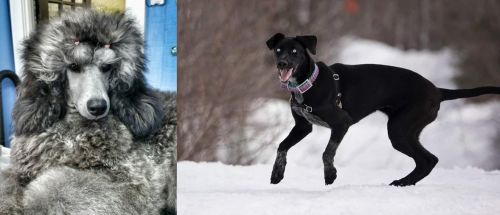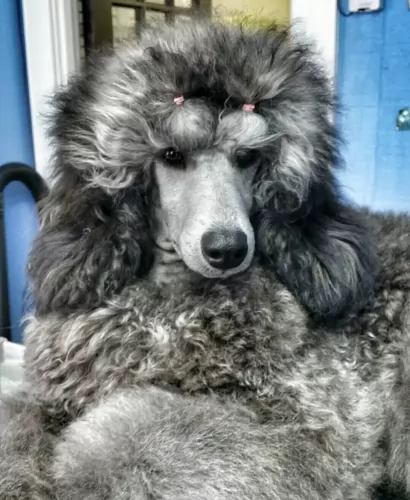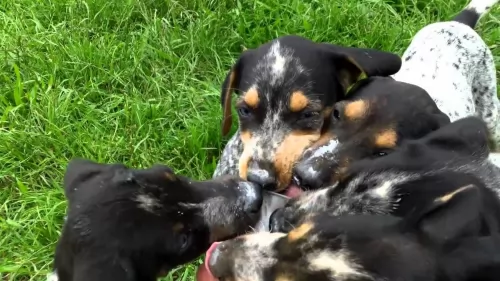 MyDogBreeds
MyDogBreeds Standard Poodle is originated from Germany but Eurohound is originated from Norway. Standard Poodle may grow 32 cm / 12 inches shorter than Eurohound. Both Standard Poodle and Eurohound are having almost same weight. Both Standard Poodle and Eurohound has same life span. Both Standard Poodle and Eurohound has almost same litter size. Standard Poodle requires Moderate maintenance. But Eurohound requires Low maintenance
Standard Poodle is originated from Germany but Eurohound is originated from Norway. Standard Poodle may grow 32 cm / 12 inches shorter than Eurohound. Both Standard Poodle and Eurohound are having almost same weight. Both Standard Poodle and Eurohound has same life span. Both Standard Poodle and Eurohound has almost same litter size. Standard Poodle requires Moderate maintenance. But Eurohound requires Low maintenance
 The Poodle is the national dog of France, and there they are known as the duck dog. The breed actually originated as a duck hunter in Germany. It was known as ‘Pudelin’ which means splashing in water.
The Poodle is the national dog of France, and there they are known as the duck dog. The breed actually originated as a duck hunter in Germany. It was known as ‘Pudelin’ which means splashing in water.
The dog has always had a crisp, curly coat to protect it from the elements. It is classified as a non-sporting dog. Soon the French became aware of what a fine dog it was and it became sought after among the elite in France.
It has been known for at least 400 years. While it is still not sure precisely from which country it comes, the poodle is a descendant of the French Water Dog which is now extinct.
 Sled dog racers wanted something unique and hardy in their dogs and the Eurohound seemed to be the dog that fitted the bill.
Sled dog racers wanted something unique and hardy in their dogs and the Eurohound seemed to be the dog that fitted the bill.
It was in the 1980s that both Norway and Sweden started crossing the Husky and the Pointer for the first time.
The Eurohound, known also as the Scandinavian hound, is a cross between a German Shorthaired Pointer and an Alaskan Husky as well as other Pointer dogs.
Hailing from Norway, Scandinavia, it isn’t a purebred dog but a cross-breed, and the term ‘Eurohound’ comes from a certain Ivana Nolke so as to distinguish the European racing dogs imported into Alaska.
 The Standard Poodle is a medium-sized dog that stands between 35 and 40cm in height and weighs between 20 - 27 kg. The coat of the standard poodle is curly and medium length and it comes in a range of different colors – black, brown, cream, apricot or white.
The Standard Poodle is a medium-sized dog that stands between 35 and 40cm in height and weighs between 20 - 27 kg. The coat of the standard poodle is curly and medium length and it comes in a range of different colors – black, brown, cream, apricot or white.
The ears are medium shaped and floppy and the tail is most times docked to half its length. The muzzle is fairly long and the eyes are brown and alert.
Standard Poodles are full of the joys of living and they are friendly, fun, playful dogs. They love playing games with the children and they make excellent family dogs.
He is quite feisty and stubborn and will require training and socialization. He is smart and is in fact, one of the most trainable of all the dog breeds.
They can adapt to life in the city or the countryside but he will need to be exercised wherever he is. The Standard Poodle isn’t aggressive but he can still make a good watchdog.
 The Eurohound is a carefully bred dog considered to be a large dog standing up to 72 cm in height and weighting in the region of 18-24 kg.
The Eurohound is a carefully bred dog considered to be a large dog standing up to 72 cm in height and weighting in the region of 18-24 kg.
With its mission being to be a sled dog, it is constantly being crossbred with other cross- breeds to produce dogs to suit the pulling of sleds. Because both the Husky and Pointers have been used in its breeding, who knows really how its appearance will be as it can vary quite a bit.
There are however, some common features in the dogs such as the half dropped ears. More Eurohounds have black ears with white markings. The dog is a slender breed with a longish face and a long muzzle. Certainly it is known for being a powerful sled dog. The short, shiny dog can be in a number of colors such as cream, beige white, red, black, spotted or patched.
Social, extrovert and energetic, the Eurohound also loves to be busy. Its a dog who forms a strong relationship with its owners, being affectionate and loyal. While he is quite able to live in the city or the country, he essentially needs large premises as he loves to run and be free.
He most certainly isn’t a working dog breed who can be left on his own in the backyard until you need him to pull a sled as he craves your companionship. He is an independent and stubborn dog and therefore training and socialization will b excellent for him as it makes him understand who is boss in the home.
He is a dog who gets on well with other pets in the home as well as children.
 Poodles are clever, easy to train and capable of living well in the city or in the countryside.
Poodles are clever, easy to train and capable of living well in the city or in the countryside.
They’re adaptable dogs too which makes them excellent family pets. They’re active and social so when you bring one into your home, you’re going to know he is there.
He wants to be involved in every aspect of your life, bonding with all members of the family, loving to spend time with each one.
He is an all-rounder and will also be a great watchdog. Loving and loyal, the Standard Poodle is ready to become your ideal pet and companion.
 Full of bounce, social and extroverted, while also being independent and stubborn, the Eurohound just loves being around his human family, bonding strongly with them, whether they are adults, children or even other pets in the home.
Full of bounce, social and extroverted, while also being independent and stubborn, the Eurohound just loves being around his human family, bonding strongly with them, whether they are adults, children or even other pets in the home.
You’ll find that your Eurohound is an intelligent dog too and that he can be easily trained. He loves to be active, so to put him in your backyard and all but forget about him would be cruel. They are loyal, loving dogs who want to be part of all your activities, being ready to walk and run with you whenever the opportunity arises.
 The Standard Poodle doesn’t have many health issues to worry about and he can live to a ripe old age of 15 or so if he is looked after well.
The Standard Poodle doesn’t have many health issues to worry about and he can live to a ripe old age of 15 or so if he is looked after well.
However, he can succumb to some of the common dog diseases there are – eye problems, skin allergies, bloat and ear infections.
Allergies in dogs can be caused by pollen, insects, food, and medicines. These allergies can all cause terrible itching, scratching, watery eyes, skin inflammation, and pain.
The ears, underarms, groin and around the eyes are often affected. It can make your pet most miserable. Your dog will have to get to the vet to relieve him of his discomfort and the vet will want a medical history to find out what is causing the problem.
 Considered as a healthy dog breed and able to live up to 10 – 15 years of age, just some of the most common reported health problems you might find with your Eurohound are hip and elbow dysplasia.
Considered as a healthy dog breed and able to live up to 10 – 15 years of age, just some of the most common reported health problems you might find with your Eurohound are hip and elbow dysplasia.
Hip dysplasia is where the joint – the ball and socket – is malformed so that instead of working smoothly it grinds. It is one of the most common skeletal diseases in dogs and large breeds are mostly affected. Hip dysplasia can lead to osteoarthritis, pain and lameness.
 The Standard Poodle will require regular brushing even though it is a low- or non-shedding breed. The curls can become matted. Some poodle owners choose to have their poodles professionally groomed and clipped.
The Standard Poodle will require regular brushing even though it is a low- or non-shedding breed. The curls can become matted. Some poodle owners choose to have their poodles professionally groomed and clipped.
The nails will need to be trimmed.
The teeth will also need to be checked if the dog will allow you to look inside his mouth. A bad, oozing tooth can cause all kinds of medical problems.
Because of the floppy ears, check inside the ears for dirt and wax buildup and signs of redness and a possible ear infection. If you don’t like to probe inside your dog’s ears or mouth, professional dog groomers will do this for you.
Your poodle is an active dog and he will need regular daily exercise. Chase him on the lawn, throw a ball for him, hide away from him and let him find you. He will also love daily walks.
Just like with any other dog, your Standard Poodle needs good, nutritional food to remain healthy. Some of the commercially manufactured dog foods you get are bad for a dog as they don’t have natural ingredients and are devoid of vitamins and minerals.
They’re certainly a convenient way to feed a dog, but try and go for the ones that are wholesome for your pet.
Home-made food such as boiled chicken, brown rice and vegetables is a good choice as it is healthy and won’t cause your dog to battle with digestive problems. Avoid spicy, exotic foods and things such as popcorn, onion, peanuts, and chocolate.
Make sure your Standard Poodle always has a bowl of fresh, cool water available.
 The Eurohound is an energetic dog who will require a high-quality nutritious food. Home made dog foods are wonderful but in the event that it isn’t always possible, make sure you buy top quality commercially manufactured food.
The Eurohound is an energetic dog who will require a high-quality nutritious food. Home made dog foods are wonderful but in the event that it isn’t always possible, make sure you buy top quality commercially manufactured food.
Your vet can advise you on the type of food to use for your pet if you are unsure. Certainly, if you feed your dog kibble, take a good look at the ingredient label on the pet food packaging. If you are interested in your dog’s health in terms of food, you will learn about protein/fat ratio and how much moisture is in the food and what vitamins are included.
Remember to occasionally include cooked brown rice, vegetables and chicken as well as some raw meat from time to time.
The Eurohound isn’t a big shedder but you will still need to ensure that you brush his short coat twice a week to keep it in tip top condition.
These are dogs which bond closely with their human family so this grooming period will be therapeutic to him.
Check his ears inside and out for the development of ear infections and brush his teeth twice a week with a special dog toothbrush and tooth paste. Dental disease can cause a host of serious illnesses and you want to avoid this with your dog,